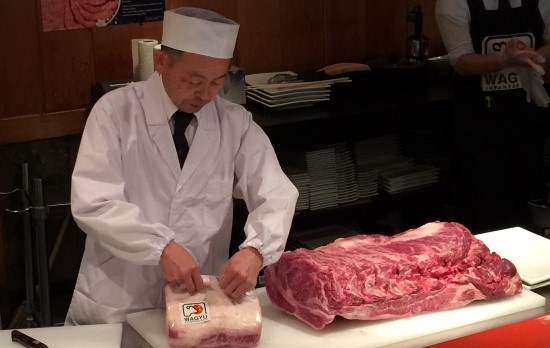Adventures in Beef: A First-Time Taste of Authentic Japanese Wagyu
Back in 2012, I was just one internet reader among millions who ended up reading a viral piece from Forbes entitled “Food’s Biggest Scam: The Great Kobe Beef Lie.” Despite the fact that I’d never personally sampled Japan’s famous Kobe beef (like a journalist has that kind of money), I found the entire issue utterly fascinating, and I quickly absorbed the piece’s several follow-ups, which tackled the definitions of “Kobe” and “wagyu” beef in America (including “American Kobe” and “American Wagyu” beef) vs. the stringent, nigh-maniacal way this terminology is actually regulated in Japan, in its place of origin. Through it all, I always hoped for the eventual opportunity to taste the high-quality Japanese beef myself, and this week I finally got that opportunity here in Atlanta.
But first, a quick breakdown of what words such as “Kobe” and “wagyu” actually mean.
“Wagyu” literally means Japanese cow, and is a blanket term referring to several Japanese cattle breeds: Primarily Japanese Black, Japanese Red/Brown, Japanese Polled and Japanese Shorthorn, of which Japanese Black makes up roughly 90 percent. These breeds are known for their production of high-quality meat, which is intricately graded to different quality levels across many cuts with an ascending price structure. In America, some breeds have been interbred with these Japanese breeds to create a knock-off “American Wagyu” or “American Kobe,” but the meat produced by these cross-breeds is typically very different in character from the full-blooded Japanese cows, often by design. In many cases, achieving the same flavor profile as the Japanese beef isn’t actually the goal, thanks to a perception that American palates don’t actually want the richness of Japanese beef and would prefer a more familiar flavor profile that is more comfortably served in significantly larger portion sizes. Because as I’m sure you will find shocking, when we eat beef, we like to eat a lot of it.
True Japanese wagyu, on the other hand, tends to be the sort of thing one might not want to eat a huge portion of—almost overwhelming in the strength of its beefy flavor and delectable fattiness. It’s like the dessert of beef. “Kobe beef” refers to a small percentage of the overall Japanese wagyu that meets extremely specific characteristics and is highly prized—it must come from one specific breed (Tajima) and be born and raised to strict standards without ever leaving Japan’s Hyogo Prefecture. If it doesn’t meet those criteria and hasn’t been appraised in Japan, then sorry—it ain’t officially Kobe. The supply of this beef is extremely small—only about 3,000 head of cattle total in the entire world. Each individual cow can be tracked via a 10-digit number through every step of its entire life cycle: That’s accurate of both Kobe and most wagyu.
 This beef can prove its citizenship more easily than you can.
This beef can prove its citizenship more easily than you can.
Thankfully, for all intents and purposes of the non-expert beef consumer, other high-quality Japanese wagyu is very close in flavor, texture and (unfortunately) price to true Kobe. Could a gourmand or restaurateur tell the difference between the two? Certainly. But if you’re not accustomed to spending hundreds of bucks on a steak? Doubtful. For that kind of consumer, some high-quality wagyu is still going to be just as foreign and fascinating an experience as true Kobe.
And so, with that in mind, I was pretty excited this week to have an opportunity to sample some authentic Japanese wagyu beef in multiple preparations without having to leave Atlanta. Thanks to visiting members of the Japan Wagyu Beef Export Promotion Committee (who brought the beef directly from Japan), restaurateurs and members of the media were able to watch as sides of beef from A5-rated Japanese black cattle were carved, cooked and served as steaks, burgers, sukiyaki and barbecue dishes. From each dish, I took a different impression away.
Steak
 Beef fat, ahoy!
Beef fat, ahoy!
We were served thin, medium-rare steaks in the first presentation to get the most direct idea of the beef’s flavor without additional flavoring, and it was immediately obvious, even to my fairly untrained palate, that this was something quite a bit different than I’d ever tasted before. The first thing one notices with the steak is juiciness—but not a factor of moisture or “bloody” juice as one might imagine in an American steak. Rather, the sensation of juiciness is fat-derived, thanks to the beef’s intense marbling. The only word for the fat is “pervasive”—spread equally through the entire piece of meat in tiny flecks, rather than appearing in bands or ribbons. These small flecks/pockets of fat ensure that each bite has roughly the same meat/fat ratio.
The other important thing about wagyu beef fat is its very low melting point. In Kobe, it can be as low as 65 degrees Fahrenheit—in our wagyu, a bit higher, but still absurdly low compared to American beef, thanks to extremely high levels of monounsaturated fat, which is liquid at room temperature. In short, this means that when you put a piece of Wagyu beef in your mouth and chew it, the warmth of your body and saliva will actively begin melting that fat, resulting in an astoundingly well-lubricated bite of meat.


